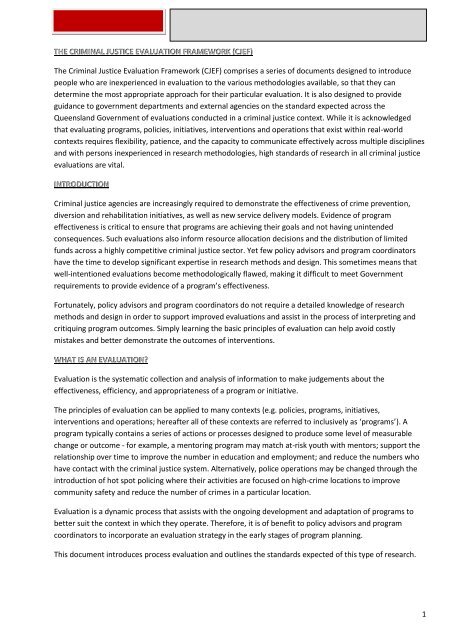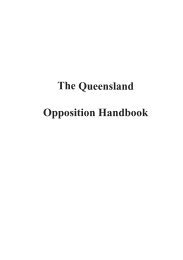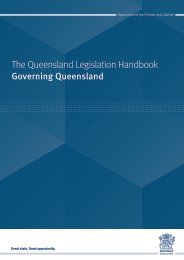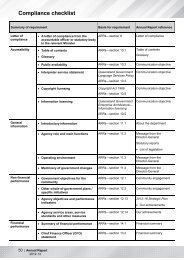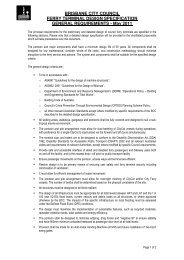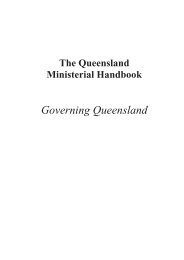Evaluating process and implementation - Department of the Premier ...
Evaluating process and implementation - Department of the Premier ...
Evaluating process and implementation - Department of the Premier ...
You also want an ePaper? Increase the reach of your titles
YUMPU automatically turns print PDFs into web optimized ePapers that Google loves.
Criminal Justice Research<strong>Department</strong> <strong>of</strong> <strong>Premier</strong> <strong>and</strong> CabinetCriminal Justice Evaluation Framework (CJEF):<strong>Evaluating</strong> <strong>process</strong> <strong>and</strong> <strong>implementation</strong>THE CRIMINAL JUSTICE EVALUATION FRAMEWORK (CJEF)The Criminal Justice Evaluation Framework (CJEF) comprises a series <strong>of</strong> documents designed to introducepeople who are inexperienced in evaluation to <strong>the</strong> various methodologies available, so that <strong>the</strong>y c<strong>and</strong>etermine <strong>the</strong> most appropriate approach for <strong>the</strong>ir particular evaluation. It is also designed to provideguidance to government departments <strong>and</strong> external agencies on <strong>the</strong> st<strong>and</strong>ard expected across <strong>the</strong>Queensl<strong>and</strong> Government <strong>of</strong> evaluations conducted in a criminal justice context. While it is acknowledgedthat evaluating programs, policies, initiatives, interventions <strong>and</strong> operations that exist within real-worldcontexts requires flexibility, patience, <strong>and</strong> <strong>the</strong> capacity to communicate effectively across multiple disciplines<strong>and</strong> with persons inexperienced in research methodologies, high st<strong>and</strong>ards <strong>of</strong> research in all criminal justiceevaluations are vital.INTRODUCTIONCriminal justice agencies are increasingly required to demonstrate <strong>the</strong> effectiveness <strong>of</strong> crime prevention,diversion <strong>and</strong> rehabilitation initiatives, as well as new service delivery models. Evidence <strong>of</strong> programeffectiveness is critical to ensure that programs are achieving <strong>the</strong>ir goals <strong>and</strong> not having unintendedconsequences. Such evaluations also inform resource allocation decisions <strong>and</strong> <strong>the</strong> distribution <strong>of</strong> limitedfunds across a highly competitive criminal justice sector. Yet few policy advisors <strong>and</strong> program coordinatorshave <strong>the</strong> time to develop significant expertise in research methods <strong>and</strong> design. This sometimes means thatwell-intentioned evaluations become methodologically flawed, making it difficult to meet Governmentrequirements to provide evidence <strong>of</strong> a program’s effectiveness.Fortunately, policy advisors <strong>and</strong> program coordinators do not require a detailed knowledge <strong>of</strong> researchmethods <strong>and</strong> design in order to support improved evaluations <strong>and</strong> assist in <strong>the</strong> <strong>process</strong> <strong>of</strong> interpreting <strong>and</strong>critiquing program outcomes. Simply learning <strong>the</strong> basic principles <strong>of</strong> evaluation can help avoid costlymistakes <strong>and</strong> better demonstrate <strong>the</strong> outcomes <strong>of</strong> interventions.WHAT IS AN EVALUATION?Evaluation is <strong>the</strong> systematic collection <strong>and</strong> analysis <strong>of</strong> information to make judgements about <strong>the</strong>effectiveness, efficiency, <strong>and</strong> appropriateness <strong>of</strong> a program or initiative.The principles <strong>of</strong> evaluation can be applied to many contexts (e.g. policies, programs, initiatives,interventions <strong>and</strong> operations; hereafter all <strong>of</strong> <strong>the</strong>se contexts are referred to inclusively as ‘programs’). Aprogram typically contains a series <strong>of</strong> actions or <strong>process</strong>es designed to produce some level <strong>of</strong> measurablechange or outcome - for example, a mentoring program may match at-risk youth with mentors; support <strong>the</strong>relationship over time to improve <strong>the</strong> number in education <strong>and</strong> employment; <strong>and</strong> reduce <strong>the</strong> numbers whohave contact with <strong>the</strong> criminal justice system. Alternatively, police operations may be changed through <strong>the</strong>introduction <strong>of</strong> hot spot policing where <strong>the</strong>ir activities are focused on high-crime locations to improvecommunity safety <strong>and</strong> reduce <strong>the</strong> number <strong>of</strong> crimes in a particular location.Evaluation is a dynamic <strong>process</strong> that assists with <strong>the</strong> ongoing development <strong>and</strong> adaptation <strong>of</strong> programs tobetter suit <strong>the</strong> context in which <strong>the</strong>y operate. Therefore, it is <strong>of</strong> benefit to policy advisors <strong>and</strong> programcoordinators to incorporate an evaluation strategy in <strong>the</strong> early stages <strong>of</strong> program planning.This document introduces <strong>process</strong> evaluation <strong>and</strong> outlines <strong>the</strong> st<strong>and</strong>ards expected <strong>of</strong> this type <strong>of</strong> research.1
WHAT IS A PROCESS EVALUATION?Process evaluations examine whe<strong>the</strong>r a particular program was implemented <strong>and</strong> operates as planned(Rossi, Lipsey & Freeman, 2004; Saunders, Evans & Joshi, 2005). Process evaluations are not intended todetermine whe<strong>the</strong>r a program achieved what it set out to achieve. For that you need to conduct an outcomeevaluation. 1Process evaluations establish <strong>the</strong> extent to which a program suited <strong>the</strong> context for which it was designed,was appropriately implemented, <strong>and</strong>/or reached those persons for whom it would provide <strong>the</strong> most benefit(Saunders et al., 2005). Once problems in program <strong>implementation</strong> have been identified it is possible to feedthis information back into <strong>the</strong> <strong>implementation</strong> <strong>process</strong> <strong>and</strong> <strong>the</strong>reby improve <strong>the</strong> program. Where a <strong>process</strong>evaluation is conducted toge<strong>the</strong>r with an outcome evaluation, <strong>the</strong> <strong>process</strong> evaluation can assist to determinewhy a program was effective or not in achieving its intended outcomes.HOW TO CONDUCT A PROCESS EVALUATIONA <strong>process</strong> evaluation is conducted in four steps:1. Identify how <strong>the</strong> program was intended to be implemented <strong>and</strong> to operate.2. Identify how <strong>the</strong> program was actually implemented <strong>and</strong> actually operates.3. Analyse data to determine whe<strong>the</strong>r <strong>the</strong> program operates as intended, <strong>and</strong> if not, why not.4. Develop recommendations <strong>and</strong> communicate findings.STEP 1: IDENTIFY HOW THE PROGRAM WAS INTENDED TO BE IMPLEMENTED AND TO OPERATEA <strong>process</strong> evaluation begins by identifying <strong>the</strong> way in which <strong>the</strong> program was intended to be implemented<strong>and</strong> to operate. With respect to <strong>the</strong> way <strong>the</strong> program was intended to be implemented, you will need toclearly establish:<strong>the</strong> intended recipients <strong>of</strong> <strong>the</strong> programhow <strong>the</strong> program was intended to be accessed <strong>and</strong> what <strong>process</strong>es were to be put in place to facilitateaccesshow <strong>the</strong> program was intended to be resourcedthose factors expected to impede <strong>implementation</strong> <strong>and</strong> how <strong>the</strong>y were to be addressedthose factors expected to facilitate <strong>implementation</strong> <strong>and</strong> how <strong>the</strong>y were to be enhanced<strong>the</strong> precise steps to be undertaken when rolling out <strong>the</strong> program.To assess how <strong>the</strong> program was intended to operate, you will need to clearly establish:<strong>the</strong> issue/s <strong>the</strong> program is intended to address<strong>the</strong> activities intended to be undertaken as part <strong>of</strong> <strong>the</strong> program<strong>the</strong> intended organisational structures <strong>and</strong> staffing patterns for <strong>the</strong> program<strong>the</strong> products, goods <strong>and</strong> services intended to be produced by, or as a result <strong>of</strong>, <strong>the</strong> program<strong>the</strong> expected outcomes <strong>of</strong> participation in <strong>the</strong> program<strong>the</strong> intended relationships between inputs, 2 outputs, 3 <strong>and</strong> outcomes 4 (i.e., how <strong>and</strong> why each input isexpected to produce a particular outcome)1 For fur<strong>the</strong>r information regarding this type <strong>of</strong> evaluation see Criminal Justice Evaluation Framework (CJEF): Conductingeffective outcome evaluations.2 An input is any resource used to produce a program output (e.g., program facilitator, funding support for <strong>the</strong> program,transport support such as a bus pass).3 An output is any good or service produced by a program for <strong>the</strong> purpose <strong>of</strong> achieving an outcome (e.g., casemanagement plan, participant accessing support services (because <strong>of</strong> a bus pass)).2
<strong>the</strong> context in which <strong>the</strong> program was intended to operate.It is important that you operationalise <strong>the</strong>se intentions in a way that is clear, concrete <strong>and</strong> measurable. Thatis, you need to precisely determine how you will know when a program is operating in <strong>the</strong> way in which itwas intended <strong>and</strong> when it is not. For example, clear <strong>and</strong> concrete indicators <strong>of</strong> <strong>the</strong> extent to which a programdelivers support services to youth in remote communities at risk <strong>of</strong> entering <strong>the</strong> criminal justice system mayinclude:<strong>the</strong> precise locations in which <strong>the</strong> program was intended to be implemented <strong>and</strong> <strong>the</strong> order in which itwas to be implemented across locations<strong>the</strong> number <strong>of</strong> youth expected to be referred to <strong>the</strong> program<strong>the</strong> proportion <strong>of</strong> youth entering <strong>the</strong> program expected to be referred to support services<strong>the</strong> proportion <strong>of</strong> youth entering <strong>the</strong> program not expected to be referred to support services <strong>and</strong> <strong>the</strong>precise reasons why<strong>the</strong> number <strong>and</strong> quality <strong>of</strong> support services thought to be available <strong>and</strong> accessible to programparticipants<strong>the</strong> expected cost <strong>of</strong> each referral.These measures are <strong>of</strong>ten referred to as administrative st<strong>and</strong>ards <strong>and</strong> may be established based on similar orpast initiatives, on <strong>the</strong> basis <strong>of</strong> <strong>the</strong> expertise <strong>of</strong> program developers <strong>and</strong> stakeholders, or on establishedscientific <strong>the</strong>ory (Rossi et al., 2004). At o<strong>the</strong>r times a program may be expected to meet established legal,ethical or pr<strong>of</strong>essional st<strong>and</strong>ards (e.g., UN Charter <strong>of</strong> Human Rights) <strong>and</strong> it is <strong>the</strong>se st<strong>and</strong>ards which form <strong>the</strong>grounds for determining whe<strong>the</strong>r a program operates or was implemented as intended. By quantifying <strong>and</strong>clarifying <strong>the</strong> intentions surrounding a program you will be better able to determine whe<strong>the</strong>r <strong>the</strong> way inwhich a program actually operates matches <strong>the</strong> expectations <strong>of</strong> program developers.In order to best quantify or clarify an intended activity, service or context, you should precisely define itscomponents in terms <strong>of</strong> its smallest part. Defining an activity in terms <strong>of</strong> its smallest part will enable you toascertain whe<strong>the</strong>r <strong>the</strong>re are differences in <strong>the</strong> way that a task is performed, which in turn can help to explainwhy a program is more or less successful in achieving its intended outcomes. For example, when referring ayoung <strong>of</strong>fender to support services a program facilitator may be expected to:conduct a needs assessmentidentify services congruent with <strong>the</strong> <strong>of</strong>fender’s needscomplete a referral formfollow-up <strong>the</strong> young person’s attendance at <strong>the</strong> referral agency.An evaluator may find that all program staff conduct a needs assessment; however, <strong>the</strong> way in which <strong>the</strong>yperform this activity may differ across locations <strong>and</strong> from <strong>the</strong> procedures put in place during <strong>the</strong> program’sdevelopment. This may explain any observed lack <strong>of</strong> fit between a young person’s needs <strong>and</strong> <strong>the</strong> service towhich <strong>the</strong>y are referred. It may also be used to inform recommendations for staff training or to account forany lack <strong>of</strong> program effectiveness observed in an outcome evaluation.That said, it is sometimes inappropriate to define an activity, service or context in terms <strong>of</strong> its smallest part.This is because <strong>the</strong> components <strong>of</strong> <strong>the</strong> activity, service or context may be different for each participant <strong>and</strong><strong>the</strong>refore could not be compared across participants. For example, in <strong>the</strong> program described above, <strong>the</strong>referral form completed on behalf <strong>of</strong> each young person may differ depending on <strong>the</strong> service to which <strong>the</strong>yare referred (e.g., support services for drug abuse versus homelessness). It would be inappropriate tocompare <strong>the</strong> extent to which information specific to each service (e.g., detailed information regarding drug4 An outcome is <strong>the</strong> subsequent effect <strong>of</strong> a program, typically as a consequence <strong>of</strong> program outputs (e.g., reduction inre<strong>of</strong>fending behaviour, reduced drug use).3
use) was provided on forms for different agencies. Instead, evaluators may like to examine broadercommonalties <strong>and</strong> differences between forms (e.g., <strong>the</strong> inclusion <strong>of</strong> <strong>of</strong>fence history, family background <strong>and</strong>results <strong>of</strong> <strong>the</strong> needs assessment) <strong>and</strong> whe<strong>the</strong>r <strong>the</strong> inclusion or exclusion <strong>of</strong> this broad information facilitated<strong>the</strong> referral <strong>process</strong>.The methods used to collect data about <strong>the</strong> way that a program was intended to operate are similar to thoseused to collect data about <strong>the</strong> way that a program actually operates (described in more detail below). Forexample, each <strong>of</strong> <strong>the</strong> following can be used to establish <strong>the</strong> way that a program was intended to operate oractually operates:interviews or surveys with program developers, key stakeholders <strong>and</strong> participantscontent analysis <strong>of</strong> program guides <strong>and</strong> policiesanalysis <strong>of</strong> documents which describe <strong>the</strong> way that a program was designed (e.g., documented<strong>implementation</strong> plan) as well as descriptions <strong>of</strong> o<strong>the</strong>r programs or <strong>the</strong>oretical positions relied on byprogram developers during program developmentexamination <strong>of</strong> parliamentary debates, ministerial statements, <strong>and</strong> explanatory notes in <strong>the</strong> case <strong>of</strong>changes introduced through legislative reform.STEP 2. IDENTIFY HOW THE PROGRAM WAS ACTUALLY IMPLEMENTED AND ACTUALLY OPERATESOnce you have identified <strong>the</strong> way that <strong>the</strong> program was intended to be implemented <strong>and</strong> operate, you areready to investigate how <strong>the</strong> program was actually implemented <strong>and</strong> operates. Again it is important that yourely on clear, concrete <strong>and</strong> reliable indicators.There are several methods that can be used to collect this information. Using a combination <strong>of</strong> approaches isrecommended, as this allows for cross validation <strong>of</strong> information <strong>and</strong> reduces <strong>the</strong> likelihood that inaccurate orinappropriate conclusions are made (Bouffard, Taxman & Sliverman, 2003). That said, try to avoid selectingtoo many indicators as this may make <strong>the</strong> data collection <strong>process</strong> onerous, expensive <strong>and</strong>/or lacking inrelevance to your research goals. In addition to identifying <strong>the</strong> type <strong>of</strong> data you will collect, it is alsoimportant to consider <strong>the</strong> factors likely to constrain or facilitate data collection. These include:<strong>the</strong> source <strong>of</strong> your data (i.e., where it will come from <strong>and</strong> <strong>the</strong> ease with which it can be obtained)<strong>the</strong> quality <strong>of</strong> <strong>the</strong> data available (i.e., is it complete, reliable <strong>and</strong> valid)how it will be collected (e.g., surveys or departmental records)who will be responsible for collecting <strong>the</strong> data<strong>the</strong> timeframes for data collection (e.g., will data be collected weekly, fortnightly or monthly).Given <strong>the</strong> known difficulties associated with collecting criminal justice data, 5 identifying how your data canbe collected may assist in limiting <strong>and</strong> refining your collection methods to those which are likely to be mostinformative, reliable <strong>and</strong> accessible for your context.A brief description <strong>of</strong> data collection methods which are typically used in <strong>process</strong> evaluations is providedbelow. The advantages <strong>and</strong> disadvantages associated with each are listed in Table 1 at <strong>the</strong> end <strong>of</strong> thissection.Stakeholder interviewsThose people who are responsible for <strong>the</strong> day to day running <strong>of</strong> a program typically have <strong>the</strong> greatest insightabout its <strong>implementation</strong> <strong>and</strong> operation. They are <strong>the</strong>refore a valuable source <strong>of</strong> information. It is important,however, that evaluators avoid conducting stakeholder interviews in an ad hoc fashion <strong>and</strong> instead rely on5 For more information see: Accessing Queensl<strong>and</strong> Government Data for Criminal Justice Research: A guide foracademics <strong>and</strong> external agencies4
structured or semi-structured methods. In structured interviews participants are asked exactly <strong>the</strong> samequestions in exactly <strong>the</strong> same order. In semi-structured interviews, participants are asked exactly <strong>the</strong> samequestions in exactly <strong>the</strong> same order <strong>and</strong> given <strong>the</strong> opportunity to elaborate on issues raised by <strong>the</strong>irresponses through additional questions developed by <strong>the</strong> interviewer in situ. The benefit <strong>of</strong> conductingstructured or semi-structured interviews over ad hoc interviews is that <strong>the</strong>y allow evaluators to compareparticipants’ responses to <strong>the</strong> same questions. This means you will be able to identify similarities <strong>and</strong>differences in participants’ responses.Content analysis <strong>of</strong> program materialsContent analysis involves reviewing written materials in a systematic way to identify common <strong>the</strong>mes <strong>and</strong> tocategorise <strong>the</strong> nature <strong>of</strong> <strong>the</strong>ir content. Any documents associated with <strong>the</strong> actual or intended<strong>implementation</strong>, promotion <strong>and</strong> administration <strong>of</strong> <strong>the</strong> program are likely to be appropriate for analysis in a<strong>process</strong> evaluation. Documents may include policy manuals, pamphlets or education materials provided toparticipants. For a comprehensive discussion <strong>of</strong> approaches to content analysis see Bryman (2008). 6Monitoring <strong>process</strong>esEvaluators may also rely on records kept by program facilitators during <strong>the</strong> course <strong>of</strong> <strong>the</strong> program. Recordkeeping by program facilitators is referred to as monitoring. In an ideal situation, an evaluator will work withprogram developers <strong>and</strong> facilitators from <strong>the</strong> outset to develop methods for efficiently <strong>and</strong> effectivelymonitoring program <strong>process</strong>es. This is <strong>the</strong> best way in which to ensure that <strong>the</strong> information collected byfacilitators is appropriate for use in subsequent evaluations <strong>and</strong> to inform ongoing program development.Monitoring is a term <strong>of</strong>ten used interchangeably with evaluation. However, <strong>the</strong> two <strong>process</strong>es are quitedistinct. Monitoring is <strong>the</strong> continuous <strong>and</strong> systematic collection <strong>of</strong> information for <strong>the</strong> purpose <strong>of</strong> informing<strong>the</strong> extent <strong>of</strong> progress towards pre-determined goals (Rossi et al., 2004). For example:Queensl<strong>and</strong> Corrective Services may record <strong>the</strong> number <strong>of</strong> Indigenous prisoners who participate in agiven program for <strong>the</strong> purpose <strong>of</strong> monitoring <strong>the</strong> extent to which a goal <strong>of</strong> 80% participation is achieved.Queensl<strong>and</strong> Treasury may monitor spending on a particular project to ensure <strong>the</strong> limits <strong>of</strong> funding arenot exceeded.Unlike data ga<strong>the</strong>red for <strong>the</strong> purpose <strong>of</strong> evaluation, data ga<strong>the</strong>red through <strong>the</strong> monitoring <strong>process</strong> is nottypically used to draw conclusions as to <strong>the</strong> effectiveness <strong>of</strong> a program or to identify ways in which aprogram may be improved.Records kept by program facilitators for monitoring purposes may be used by evaluators to identify what isactually delivered by a program <strong>and</strong> to whom it is delivered (i.e., program coverage <strong>and</strong> program bias). Forexample, service delivery measures <strong>of</strong> a drug treatment program might include <strong>the</strong> number <strong>of</strong> graduatesfrom <strong>the</strong> program, <strong>the</strong> number <strong>of</strong> treatment sessions administered, or <strong>the</strong> number <strong>of</strong>information/promotional pamphlets given to potential participants. The extent to which persons for whom<strong>the</strong> program was intended (target population) participate reflects program coverage <strong>and</strong> program bias (Rossiet al., 2004).An analysis <strong>of</strong> program coverage considers whe<strong>the</strong>r <strong>the</strong> number <strong>of</strong> persons from <strong>the</strong> target population whoaccess <strong>the</strong> program is consistent with <strong>the</strong> intended number <strong>of</strong> target participants (Rossi et al., 2004). Ananalysis <strong>of</strong> program bias considers whe<strong>the</strong>r subgroups within a target population are more or less likely toparticipate (Rossi et al., 2004). Bias may be a function <strong>of</strong> self-selection (e.g., a particular subgroup is morelikely to volunteer for <strong>the</strong> program) or program actions (e.g., failure to advertise <strong>the</strong> commencement <strong>of</strong>6 Colorado State University provides a free guide to content analysis athttp://writing.colostate.edu/guides/research/content/ [accessed August 2011]5
programs in an appropriate way or to conduct <strong>the</strong> program in an appropriate location for a specificsubgroup). In order to measure <strong>the</strong> extent to which a participant population is biased towards a particularsubgroup <strong>of</strong> <strong>the</strong> target population, evaluators can draw on monitoring information to determine <strong>the</strong>characteristics <strong>of</strong> those who drop out <strong>of</strong> <strong>the</strong> program or who are eligible but do not participate.SurveysSurveys can also be used as a means <strong>of</strong> collecting information about <strong>the</strong> way that a program wasimplemented or operates. For example, participant surveys may be used to identify participantcharacteristics <strong>and</strong> <strong>the</strong> extent to which <strong>the</strong>re is <strong>implementation</strong> bias among <strong>the</strong> individuals engaged by <strong>the</strong>program. Community surveys may be used to determine why potential c<strong>and</strong>idates were not or did notengage in <strong>the</strong> program. Stakeholder surveys can be used to collect anonymous information regarding <strong>the</strong>way that a program was implemented or operates.When conducting survey research it is important that <strong>the</strong> sample is appropriately representative <strong>of</strong> <strong>the</strong>actual participant population, or, where <strong>the</strong> parameters <strong>of</strong> <strong>the</strong> actual participant population is unknown(e.g., a television-based education program which is broadcast nation-wide), representative <strong>of</strong> <strong>the</strong> eligibleparticipant population. 7Finally, it is important that <strong>the</strong> survey questions relate specifically to <strong>the</strong> goals <strong>of</strong> <strong>the</strong> program <strong>and</strong> <strong>the</strong> extentto which <strong>the</strong>y were or were not achieved, <strong>and</strong> why. This ensures that <strong>the</strong> information collected by surveyscan be used effectively to draw conclusions from <strong>the</strong> <strong>process</strong> evaluation.Systematic social observationSystematic social observation is a data collection technique used to systematically identify <strong>the</strong> characteristics<strong>of</strong> a particular social environment (Bouffard et al., 2003). Data is collected through observations structuredaround pre-determined categories <strong>and</strong> specific research questions. It is important that observations arerecorded according to structured, replicable procedures as this allows for comparison across time <strong>and</strong>locations. Observations are typically made by research <strong>of</strong>ficers who are extensively trained in <strong>the</strong> purpose<strong>and</strong> <strong>process</strong> <strong>of</strong> observation. Systematic observations will increase <strong>the</strong> value <strong>of</strong> a <strong>process</strong> evaluation as <strong>the</strong>yallow evaluators to use <strong>the</strong> scientific method to observe program <strong>implementation</strong> first h<strong>and</strong> <strong>and</strong> to compareresults with stakeholders’ descriptions <strong>of</strong> program operations (Bouffard et al., 2003). It may also be worthnoting that observations made consistently over a long period <strong>of</strong> time can sometimes be more informativethan those made in <strong>the</strong> short term. This is because:participants who alter <strong>the</strong>ir behaviour in response to observers may be more likely to relax over timeevaluators are exposed to more <strong>and</strong> varied situationsevaluators may be able to follow one cohort <strong>of</strong> participants throughout <strong>the</strong>ir involvement in <strong>the</strong>program.Taking significant steps to guarantee anonymity <strong>and</strong> confidentiality will also assist to discourage participantsfrom behaving in ways o<strong>the</strong>r than <strong>the</strong>y normally would.7 For an introduction to selecting a representative sample, see Criminal Justice Evaluation Framework (CJEF): Conductingeffective outcome evaluations.6
Table 1. The advantages <strong>and</strong> disadvantages associated with different data collection techniques used in<strong>process</strong> evaluations.Method Advantages DisadvantagesStakeholder interviews - unique insight into program<strong>implementation</strong> <strong>and</strong>administration- <strong>the</strong> information provided bystakeholders may be inaccurateor incomplete because <strong>of</strong> bias<strong>and</strong> <strong>the</strong> extent <strong>of</strong> informationabout <strong>the</strong> program to which <strong>the</strong>stakeholder is exposedContent analysis - credible, non-biased data source - this approach to analysinginformation can be timeconsumingMonitoring <strong>process</strong>es - a clear quantitative measure <strong>of</strong>service deliverySurveys - inexpensive <strong>and</strong> fast to conduct- can be used with large, dispersed<strong>and</strong>/or geographically diversepopulations- can be used to address manytopics or to ask many questionsabout a single topic- allow for <strong>the</strong> same informationto be collected from differentgroups <strong>and</strong> over time- usually highly reliable method <strong>of</strong>data collectionSystematic socialobservation- data can be collected in a waythat is independent <strong>of</strong> anyindividuals directly involved inprogram <strong>implementation</strong>- accuracy is dependent on <strong>the</strong>accuracy with which <strong>the</strong>information is collected- extracting, analysing <strong>and</strong>interpreting data can be timeconsuming if it was not collectedfor <strong>the</strong> purposes <strong>of</strong>substantiating an evaluation- to make questions relevant to avariety <strong>of</strong> participants surveys<strong>of</strong>ten generalise across concernswhich has <strong>the</strong> potential ignoresubtle differences in participants’experiences- inflexible (i.e. to enablecomparison over time questionscannot change)- difficulty gaining high responserates from participants- cannot control for/account for<strong>the</strong> impact <strong>of</strong> <strong>the</strong> broadercontext in which <strong>the</strong> program isadministered on participants’responses- potential for response bias (i.e.<strong>the</strong> participants answer <strong>the</strong>question <strong>the</strong> way <strong>the</strong>y thinkevaluators want <strong>the</strong>m to)- can take time <strong>and</strong> effort todesign (e.g., may requireextensive pilot testing to ensurequestions address <strong>the</strong> issueappropriately)- can be time <strong>and</strong> resourceintensive7
STEP 3. ANALYSE DATAAnalysis <strong>of</strong> <strong>the</strong> data should aim to do <strong>the</strong> following (Rossi et al., 2004):describe <strong>the</strong> way in which <strong>the</strong> program actually operateso who participates, who does not participate <strong>and</strong> whyo what services are provided by <strong>the</strong> program <strong>and</strong> what outputs are producedo how do participants perceive/use <strong>the</strong> services providedcompare <strong>the</strong> way in which a program operates across different sites (when a program has beenimplemented in more than one site)o demonstrate any diversity across program sites (e.g., staff, administration, <strong>and</strong> broader context)o identify whe<strong>the</strong>r it is appropriate for activities or outputs to be st<strong>and</strong>ardiseddescribe <strong>the</strong> extent to which <strong>the</strong> program conforms with its intended designo identify whe<strong>the</strong>r a program performs its functions as intendedo where a program does not function as intended describe whyo determine whe<strong>the</strong>r it is appropriate to next conduct an outcome evaluation to determine <strong>the</strong>effectiveness <strong>of</strong> <strong>the</strong> program.Quantitative data (i.e., numerical data) should be analysed using appropriate statistical methods <strong>and</strong>presented appropriately in text, tables or graphs. Qualitative data (i.e., descriptive accounts, observations<strong>and</strong> interviews) should be analysed (using available s<strong>of</strong>tware packages where <strong>the</strong> quantity <strong>of</strong> qualitative datacollected makes this appropriate) to identify major <strong>the</strong>mes, categories, issues <strong>and</strong> incidents relevant to <strong>the</strong>evaluation. Particularly succinct or expressive quotes should be used to support or provide examples <strong>of</strong> anyconclusions drawn from qualitative data.STEP 4. MAKE RECOMMENDATIONS AND CLEARLY COMMUNICATE YOUR FINDINGS TO OTHERSCommunicating your findings with conciseness <strong>and</strong> clarity will improve <strong>the</strong> chances <strong>of</strong> yourrecommendations being understood <strong>and</strong> implemented. Effective communication begins by identifying who ismost likely to read your report (e.g., program stakeholders, those directly involved in <strong>the</strong> program, policy <strong>and</strong>decision makers, or a combination <strong>of</strong> <strong>the</strong>se) <strong>and</strong> <strong>the</strong>ir motivation for reading it (e.g., what will yourrecommendations be used for?). Knowing your audience <strong>and</strong> <strong>the</strong>ir needs will <strong>the</strong>n help you to decide whatinformation should be included in <strong>the</strong> report, <strong>the</strong> way in which it should be structured, <strong>and</strong> how to support<strong>the</strong> argument you are making (e.g., <strong>the</strong> program operates as intended; <strong>the</strong> program needs to be changed).For example, it may be more appropriate for your findings to be released in a series <strong>of</strong> papers, each <strong>of</strong> whichtargets <strong>the</strong> select needs <strong>of</strong> a unique audience, than as a single report. Alternatively, your audience mayrespond better to workshop-style presentations or community meetings.While <strong>the</strong> needs <strong>of</strong> your audience should play a key role in determining <strong>the</strong> way in which you communicateyour findings <strong>and</strong> to some extent <strong>the</strong> level <strong>of</strong> detail you provide, <strong>the</strong>re are some key components every<strong>process</strong> evaluation report should include. These are: a description <strong>of</strong> <strong>the</strong> program being evaluated <strong>and</strong> <strong>the</strong> context in which it operates a statement containing <strong>the</strong> specific research questions addressed an explanation <strong>of</strong> <strong>the</strong> methods <strong>and</strong> measures used to collect <strong>the</strong> data <strong>the</strong> results found from <strong>the</strong> evaluation any limitations <strong>of</strong> <strong>the</strong> data, data collection <strong>and</strong> evaluation a clear explanation <strong>of</strong> <strong>the</strong> answers provided to <strong>the</strong> research questions on <strong>the</strong> basis <strong>of</strong> <strong>the</strong> data collected any recommendations made on <strong>the</strong> basis <strong>of</strong> <strong>the</strong> results8
oooo<strong>the</strong> need to move <strong>the</strong> <strong>implementation</strong> <strong>of</strong> a project closer to <strong>the</strong> original design <strong>and</strong> how this mightbe achieved<strong>the</strong> need to change <strong>the</strong> design <strong>of</strong> <strong>the</strong> original program to better suit <strong>the</strong> participants or context <strong>of</strong><strong>implementation</strong><strong>the</strong> appropriateness <strong>of</strong> conducting an outcome evaluationdescription <strong>of</strong> <strong>the</strong> way in which information will be fed back to improve program <strong>implementation</strong>.MORE QUESTIONS ABOUT EVALUATING?If you are having trouble establishing a good evaluation framework or have any questions about evaluationplease contact Criminal Justice Research, <strong>Department</strong> <strong>of</strong> <strong>the</strong> <strong>Premier</strong> <strong>and</strong> Cabinet (Ph: 32278436) or consult<strong>the</strong> references listed below.9
REFERENCESAccessing Queensl<strong>and</strong> Government Data for Criminal Justice Research: A guide for academics <strong>and</strong> external agencies. Available on <strong>the</strong><strong>Department</strong> <strong>of</strong> <strong>the</strong> <strong>Premier</strong> <strong>and</strong> Cabinet website [http://www.premiers.qld.gov.au]Bouffard, J.A., Taxman, F.S., & Silverman, R. (2003). Improving <strong>process</strong> evaluations <strong>of</strong> correctional programs by using acomprehensive evaluation methodology. Evaluation <strong>and</strong> Program Planning, 26, 149-161.Bryman, A. (2008). Social research methods. Third Edition. Oxford University Press. Oxford, UK.Criminal Justice Evaluation Framework (CJEF): Top five tips for conducting effective outcome evaluations. Available on <strong>the</strong><strong>Department</strong> <strong>of</strong> <strong>the</strong> <strong>Premier</strong> <strong>and</strong> Cabinet website [http://www.premiers.qld.gov.au].King, J.A., Morris, L.L., & Fitz-Gibbon, C.T. (1987). How to assess program <strong>implementation</strong>. Sage Publications, California, USA.Rossi, P.H., Lipsey, M.W., Freeman, H.E. (2004). Evaluation: A systematic approach. Seventh Edition. Sage Publications, California,USA.Saunders, R.P., Evans, M.H., & Joshi, P. (2005). Developing a <strong>process</strong>-evaluation plan for assessing health promotion program<strong>implementation</strong>: A how-to guide. Health Promotion Practice, 6(2), 134-147.Writing Guide: Content Analysis. Available on <strong>the</strong> Colorado State University websitehttp://writing.colostate.edu/guides/research/content/ [accessed August 2011]10


